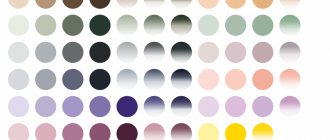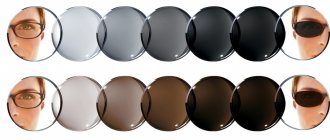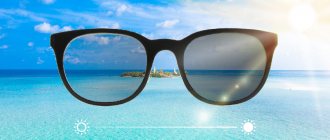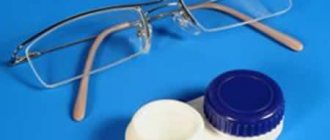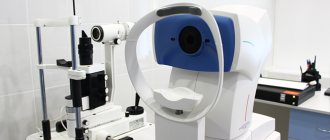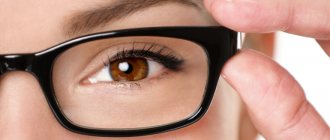Photochromic lenses
The purpose of such products is to adjust the darkening level of the eyepieces depending on the level of room illumination. Outdoors, when exposed to sunlight, the lenses darken. In the room, the product again becomes transparent and takes on the characteristics of ordinary glasses for vision correction. Photochromic elements are responsible for changing the shade, which react sharply to UV rays and lighting intensity.
Chameleon glasses act as a kind of filter that transmits a limited amount of light flux. This protects the organ of vision from excess ultraviolet radiation. However, the product is not designed for prolonged exposure to direct sunlight. If you are planning to go to the beach, you should stock up on classic tinted glasses.
Photochromic lenses work well under any temperature fluctuations; they do not fog up and do not lose their light-sensitive characteristics. This product is recommended in the following cases:
- Problems with visual acuity;
- Thinning of the retina;
- For preventive purposes against the development of cataracts;
- UV blocking.
Also, chameleon sunglasses are suitable for people who spend a lot of time in the direct rays of daylight: fishermen, athletes, drivers.
| Photochromic products are good at eliminating any deviations in visual function. The level of darkness varies from 15 to 85%. When making lenses, a unique technology is used; photochrome is distributed evenly over the entire surface of the glass and penetrates to a certain depth. |
What are photochromic glasses: how they work
Such accessories use lenses with photochromic substances included in them. When exposed to UV rays, photochromic lenses darken and return to their original color indoors. That's why they are also called chameleons
.
The degree of darkening of chameleon glasses depends on the intensity of sunlight - the more sunlight there is, the more the photochromes change their molecular structure. The dimming ranges are divided into three groups according to intensity:
● 10-55% - low dimming;
● 15-65% - medium darkening;
● 30-85% - the highest darkness; such lenses are necessary for people with increased sensitivity to light.
Photochromic lens material
There is a wide range of products on the market. However, before purchasing, you should consult with an ophthalmologist and undergo a visual acuity test. Organic or inorganic (mineral glass) raw materials are used to make lenses. The models also differ in the degree of refraction of light fluxes.
The mineral photochrome is distributed evenly in the liquid glass during the cooking process. Several methods are used to create organic eyepieces:
- Glass impregnation;
- Volumetric distribution of photochrome over the entire surface;
- Application of a unique coating.
The technique of creating organic lenses has been used for a very long time, it is often used in SunSensors technologies. Impregnation (imbibing) is characterized by the introduction of elements in a uniform layer to a depth of approximately 0.15 millimeters. A protective coating is then applied to the surface of the eyepieces. The technology is actively used by Tranitions Optical.
Photochrome is applied to the front side of the lens. To securely secure the unique coating, an additional reinforcing layer is applied. Modern products are elastic, withstand mechanical loads well and are made from environmentally friendly raw materials. The universal material provides a high level of darkness outdoors and absolute transparency indoors. Chameleon sunglasses are available in brown or gray.
Photochromic eyepieces are often equipped with a multifunctional coating that ensures wearing comfort. Product designs are varied, expensive models become the “highlight” of any image. The optics do not deform under high temperatures and are scratch resistant.
Varieties
The product is presented in various variations. They can be bifocal, progressive, etc. This allows you to select eyepieces for people suffering from various ophthalmological ailments. Thanks to the use of innovative techniques, chameleons are created with diopter inserts, in accordance with the recipe provided by the person. If there are no vision problems, buy optics without diopters.
According to the production method, eyepieces are divided into organic and mineral. The latter have a long service life, are highly resistant to ultraviolet radiation, but often provide non-uniform dimming.
Organic models do not have this problem, but wear out very quickly and must be replaced. On average, the shelf life of eyepieces is from three to five years, and their darkening ability gradually decreases. For this reason, doctors do not recommend using a new and old lens at the same time, since they will have different effects. Return to contents
With diopters
This option is suitable for people with vision problems. Previously, they had to carry sunglasses and products to combat refractive errors, which tend to break at the most inopportune moment. With the advent of chameleons, this problem disappeared.
| Photochromic lenses reduce the load on the visual apparatus, since it does not need to adjust to a new level of lighting several times a day. If in addition the patient suffers from photophobia or severe lacrimation, then chameleons will be a real salvation for them. |
By purchasing high-quality glasses with photochromic lenses, you can prevent the development of dangerous pathologies such as cataracts or retinal dystrophy.
Bicycle
The popularity of this type of transport is increasing every year. Increasingly, young people who care about their health and physical fitness are choosing bicycles. In addition, no traffic jams are scary with it. Both amateurs and professionals need additional eye protection.
Bicycle chameleons equipped with diopter lenses have several advantages:
- Protect from the blinding sun;
- Act as a barrier against harmful ultraviolet radiation;
- Prevents exposure to glare from snow (if we are talking about a mountain bike);
- Protect from wind, insects, dust particles;
- Do not allow low-lying tree branches to injure your eyes.
When choosing such eyepieces, pay attention not only to their properties. They should sit well on the bridge of the nose, not fall off, and fit snugly on the sides. It is also worth choosing not glass variations, but purchasing sports models with polymer lenses. This will minimize the risk of eye damage in the event of an unfortunate fall.
For athletes
Photochromic glasses are an indispensable accessory for people who are professionally involved in sports. They not only protect the eyes, but also do not limit physical activity. Snowboarders, runners, etc. cannot do without chameleons. The product will help you think exclusively about high results, and not about lumps of dust or snow flying into your eyes.
Photochromic eyepieces equipped with diopter lenses independently adjust the degree of darkness depending on weather conditions, protect against UV rays and make it possible to train without regard to the climate.
Such products are universal. They are used by professional athletes and “savage” tourists. Chameleons greatly facilitate the process of moving along the chosen route and ensure the safety of the traveler.
For drivers
Polarized glasses with diopters are a must-have accessory for car enthusiasts. According to statistics, approximately thirty percent of all accidents on the highway occur due to the driver being blinded by the headlights of an oncoming car or glare from puddles. Chameleons with diopters provide complete eye protection and block harmful UV rays.
Previously, drivers could only wear glasses with diopters, which did not prevent exposure to ultraviolet radiation on the organ of vision. In addition, photochromes did not darken the interior of the car, since UV rays did not penetrate the glass. Now manufacturers offer models that respond to blue spectrum rays (i.e. short-wavelength). This allows the lenses to darken even behind car windows, additionally relieving the motorist of blinding glare and protecting against ultraviolet radiation.
| Ophthalmologists do not recommend that drivers wear such products at night, since the effect of the lenses can be unpredictable. The glasses change color depending on the light intensity. |
In bad weather, they acquire a yellow-green tone, in the car interior they become copper, and in bright sunlight they turn brown. The light absorption characteristic is also adjusted, from 65 to 89%.
Chameleon glasses
Smart molecules
The phenomenon of photochromism is based on the ability of the molecules of certain substances (for example, silver and copper) to change their structure under the influence of ultraviolet radiation. In their initial state, these molecules have a high degree of light transmittance (the glasses are transparent), but as soon as UV rays hit them, they are activated and transmit much less light (the glasses become gray or brown). If the sun disappears, the molecules return to their original state, and the glasses again turn colorless.
It's comfortable. Firstly, vision correction occurs continuously. Secondly, you don’t need to take off your glasses and put on sunglasses when going outside, and do the reverse process when going indoors.
From Photolite to Transitions
The phenomenon of photochromism was discovered at the end of the 18th century. In the twentieth century, not only physicists, but also manufacturers of spectacle lenses became interested in it.
In 1964, Corning Glass Works released the first photochromic-coated lenses, Photolite. These were glasses with glass lenses on which silver and copper halides were applied. In the 1980s, photochromic coatings began to be applied to organic lenses.
But the real “revolution” occurred in 1991, when PPG Industries and Essilor International merged (Transitions Optical) and jointly developed Transitions technology. This technology has become one of the most popular.
Glass or plastic – what to choose?
Mineral (glass) and organic (plastic) photochromic lenses differ in the production method and some properties. Therefore, the question often arises - which is better?
In glasses with mineral lenses, the photochromic elements are “inside” - they are added when the glass is melted. On organic lenses, photochromic molecules are usually applied “on top”.
In terms of properties, modern inorganic and organic lenses with photochromic coating are practically indistinguishable from each other. However, polymer spectacle lenses “darken” more evenly; in mineral lenses, darkening sometimes “accumulates” along the edges or in the center of the lenses.
In principle, it is not so important what material the glasses are made of - lenses with photochromic coating will in any case protect the eyes from ultraviolet radiation.
Alone instead of a couple
Many people choose glasses with photochromic coating, believing that they will replace prescription glasses and sunglasses. This is true if you alternate between being indoors and outdoors.
Depending on the type of photochromic lenses, they can provide up to 90% darkness, which means they are, in principle, suitable for wearing on the beach. However, most often photochromic lenses are inserted into frames for permanent wear, which are smaller in size than the frames of beach glasses. But this is a matter of aesthetics and personal preference.
The “behavior” of photochromic lenses depends on the air temperature: they darken in the heat, but more slowly and less; in cold weather, on the contrary, the darkening occurs more intensely.
Manufacturers of spectacle lenses are actively working to improve photochromic coatings. Over a million chameleon glasses are sold annually, and demand is only growing. Photochromic lenses are emerging for people who spend a lot of time driving or outdoors, in bright sunshine and at high temperatures. These lenses provide greater darkness and maintain it in hot weather.
There are also lighter photochromic lenses for people who spend a lot of time indoors. Tinted photochromic lenses and lenses with unusual curves are appearing for fashionable frames.
Overall, it is now easy to find photochromic lenses that will suit your lifestyle and the frames you want to wear. And modern coatings will help protect your eyes from UV rays and bright light.
Benefits of photochromic glasses
Ideal option for patients with poor vision. They sometimes have to buy two pairs of corrective products, one (darkened) for being outdoors, the second (transparent) for working indoors. Chameleons will become an alternative to such optics and eliminate the need to carry an entire “arsenal” with you.
In the room, the lenses do not darken because the glass does not transmit harmful ultraviolet radiation. Eyepieces have several undeniable advantages:
- Provide protection from UV rays;
- Do not restrict visual visibility;
- Allowed for use both indoors and outdoors;
- Prevention of ophthalmological diseases;
- Versatility of use.
Photochromes protect 100% from ultraviolet radiation, while transmitting light well and quickly reacting to the slightest changes in the degree of illumination. At the same time, eye strain is reduced and the contrast of perception is increased. This is extremely important for patients suffering from excessive lacrimation or photophobia. Return to contents
Benefits of glasses with photochromic lenses
Photochromic glasses have several important advantages:
- There is no need to use several pairs of glasses, that is, for vision and for sun protection.
- You can choose a lens design to suit your aesthetic needs and face type.
- Can be worn indoors or while driving a car. They will not darken and impair visibility.
- They protect the eyes almost 100% from ultraviolet radiation, thereby reducing eye strain, increasing image contrast, and preventing the development of eye diseases.
Chameleon glasses also have medical indications. They are prescribed after an ophthalmological disease or eye surgery. They also help people with increased eye sensitivity to light. As a preventive measure for cataracts, photochromic glasses are often recommended by ophthalmologists to elderly patients, as well as those who suffer from degenerative retinal diseases.
This type of optics also has minor disadvantages. But every year there are fewer and fewer of them, as lens manufacturing technologies are improved. One of the “cons” is related to the small range of colors. Today there are three types of photochromic glasses based on the number of shades - gray-green, gray and brown.
Another disadvantage of chameleons is their limited service life. They can quickly lose their darkening properties as a result of constant rubbing, as well as scratches on their surface. Now some manufacturers coat glass with a special protective varnish, which increases the service life of the products. Unfortunately, this also affects the cost of such optics. Although it is worth considering the fact that chameleon glasses, in principle, are much more expensive than standard correction products.
Who is it suitable for?
Chameleon glasses for vision are an ideal choice for people with vision problems, but at the same time leading an active lifestyle. The products will be an ideal option for car enthusiasts and tourists. Photochromic lenses successfully combine optics for vision correction and eyepieces for sun protection.
There are also medical reasons for wearing chameleons. These include the risk of developing cataracts and dystrophic pathologies of the retina. The use of unique glasses will help this category of patients avoid the progression of diseases and is considered as one of the main measures to prevent their occurrence.
How to choose
To avoid making a mistake with your choice, follow some recommendations:
- Decide what type of lenses you need (bifocal, progressive, etc.);
- The choice of eyepieces depends on your lifestyle. If you regularly spend time outdoors and in the sun, purchase lenses made from mineral raw materials. For those who often work indoors, organic models are suitable;
- Carefully study the assortment presented in the optical salon. It is better to purchase a product from well-known manufacturers. Placing an order for custom lenses will increase the likelihood that the eyepieces will match the indicated dioptres and are made in the color scheme that you like.
| If you cannot select eyepieces on your own, consult a doctor for help. Visit an ophthalmologist, undergo a visual acuity test and get professional advice on choosing chameleon eyepieces. |
TOP 5 best photochromic lenses
When purchasing optics, pay attention to the following factors:
- Minimum degree of darkness. Indicates how transparent the eyepiece is under normal conditions;
- Maximum dimming setting. Shows how dark the glasses will be in bright light. The higher the indicator, the more the product costs;
- Speed reaction. The first models slowly darkened and also “inhibited” returned to their normal state. With modern glasses, the process takes a few seconds;
- Use in the car. If you plan to wear eyepieces in a car, make sure that they will darken inside the car;
- Availability of additional coating (dirt-repellent, ultra-durable, etc.).
The price of the product and the comfort of use directly depend on these parameters. However, we can note the best options with an ideal cost/quality ratio.
Cantilen Clear Vision Photo 1.56
Lenses from a Russian manufacturer. Made of polymer, they belong to budget models. However, they cope well with the main function of protection against UV rays. The eyepieces have an additional coating that not only repels dirt, but also acts as a barrier against electromagnetic radiation.
Diopter range from minus eight to plus six. Since the lenses do not have a cylinder, they are not suitable for astigmatists. At high diopters, the eyepieces will be very thick because they have a low degree of refraction (only 1.56). The product is presented on the market in two diameters - sixty-five and seventy. The color range is limited to brown and gray. The cost of the goods is 1200 rubles.
Rodenstock Perfalit 1.54 ColorMatic
Ideal value for money. The cost of eyepieces is three thousand rubles. Made from polymer of organic origin. In bright light they provide a dimming level of up to 85%. There is a residual effect in the room, i.e. The eyepieces do not become completely transparent.
The diopter range is limited from minus six to plus four. The lens is not very thin, refractive index 1.54. Available in two classic shades – brown and grey. The glass surface is coated with SPP or Duralux. The first is a nanotech layer with many functions, from repelling dirt to increasing strength. Duralex strengthens the eyepiece. The lens reacts almost instantly to changes in light levels.
HOYA DriveWear Hi-Vision Aqua 1.5
Japanese products are intended for motorists. The cost of the goods is ten thousand rubles. The lenses have a high-quality polarizing coating and sensitive photochrome, which changes darkness in a couple of seconds. The eyepiece is single-focus, the diopter range is from minus nine to plus seven and a half. The cylinder is missing. On the street, the degree of darkness reaches 85%, in the car the figure drops to 50%.
They have three coatings: HVA (brightens and repels dirt), SHV (adds strength), HVLL (combines the characteristics of HVA and SHV). The lens has a moderate thickness, refractive index – 1.5. You can wear glasses only during the day; it is not recommended to use them at night. Return to contents
Essilor 1.59 Airwear Transitions Signature 7 polycarbonate Crizal Alize + UV
High quality and versatile product. Suitable for working at a computer. French goods cost around six thousand rubles. The lens is lightweight and protects from ultraviolet radiation. The eyepiece is made of impact-resistant polycarbonate, on top of which an additional layer of Crizal Alize+ UV is applied. Dust and dirt do not linger on the glass. The coating increases durability.
A single vision lens can be purchased with a diopter rating from minus six to +5.75. The refractive index is 1.59, so the eyepiece cannot be called ultra-thin, but it looks good. The optics are available in gray and brown shades. In bright light, the dimming rate is 88%.
Top Vision ASP 1.67 Transitions XTRActive HMC
Russian lenses provide the maximum degree of darkening in light - 90%. The cost of production is ten thousand rubles. An ideal choice for people with an active lifestyle. The diopter range is from -10 to +8.75. They are equipped with a cylinder (from plus to minus four), so they are allowed to be used for astigmatism. Refractive index – 1.67.
There is an additional layer that has beneficial properties. Eliminates glare, repels dirt and water, increases strength and has antistatic properties. The initial darkening of the eyepiece is 11%, so even indoors they will not become completely transparent. Inside the car, the indicator is 50%, so drivers will be comfortable driving even on a bright sunny day.
Color and shading
Glasses with photochromic lenses (no matter with or without diopters) differ in the degree of darkening. In different models it can range from 10% to 85%. As for color, lenses with gray or brown glasses are most often found. But today, thanks to new technologies, you can buy glasses with photochromic lenses of other colors and shades. You can choose them in our Healthy Vision optical salons in St. Petersburg. Here you can select and buy men's or women's photochromic glasses with or without diopters at affordable prices, or order the production of photochromic lenses for your glasses.
